Rules for maintaining a cast iron pan and how to restore its properties, errors
Cast iron cookware is reliable and durable. Before the invention of the non-stick coating, millions of housewives cooked dishes with an appetizing crust in cast iron pans, which served faithfully for decades and were passed down from generation to generation. Heavy metal kitchen utensils are still popular today. Consider the rules for caring for a cast-iron cauldron and a frying pan, the tricks of experienced housewives that help preserve the properties of dishes for many years.
Particularities of cast iron
Cast iron cauldrons, braziers, pans are easy to identify - they are impressively heavy, with thick walls and a bottom. Food cooked in such a dish tastes and smells excellent, does not burn, stays hot for a long time, “reaches” after the end of cooking.
The main advantages of the material:
- slow heating, even heat distribution (food does not burn in the place where heating occurs);
- the dishes are made of pure cast iron or covered with enamel (usually cauldrons);
- durability and high strength (lasts for decades);
- respect for the environment (harmlessness) - does not emit dangerous elements into food and air;
- easy maintenance;
- does not scratch - spoons, knives and forks will not damage the coating.
Now let's recall the main problems of cast iron cookware:
- tendency to corrosion - objects not covered with enamel rust with excess moisture;
- fragility - in the event of a fall or a sharp drop in temperature, it can crack;
- absorbs food odors - it is not recommended to store cooked food in a pan.
Many people find a heavy skillet difficult to handle. Frying pancakes on it is really tricky - you need strong hands. But an even blush, lots of holes and a wonderful taste are provided.
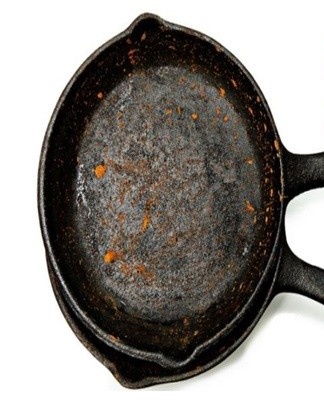
Processing new dishes
The initial treatment of a new frying pan is essential, as it requires burning off foreign material from the surface and creating non-stick properties. Preparation for use takes place in 3 steps:
- Rinse the pan with hot water and soap (preferably household soap). Industrial pollution and traces of oil are eliminated from the dishes.
- Burning. For calcination, use a stove, oven or open fire. The easiest way to burn the pan is on the stove. Coarse rock salt (1-1.5 kilograms) is poured, set on fire. Ensure good ventilation in the room. They heat on the fire, stirring the salt and constantly picking it up to the walls. The process ends when the salt turns dark (about half an hour). Pour salt, cool the pan, wash again.
- Vegetable oil is poured into the dishes, set on fire and lit for another 10-20 minutes, also moistening the walls with fat.
The oil is drained, residues are carefully removed from the bottom and walls with paper towels. Oil impregnation will serve as a release layer in the future.
Rules of daily care
Daily care can only be talked about if cast iron cooking utensils are used every day. If the hostess has a lot of pots that she uses according to her mood and needs, it is important to ensure the proper storage of the cast iron utensils.
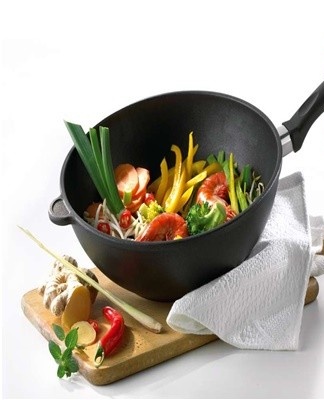
Enamel coated
Frying pans and cauldrons covered with a layer of enamel are ideal for boiling and simmering for a long time. The enamel layer adheres firmly to the cast iron, so as not to chip or destroy it, the following maintenance rules must be observed:
- do not put hot dishes under cold water;
- do not clean with abrasive powders;
- after removing the food, warm water is poured into cold dishes, mild soap is added, left for 20-60 minutes, washed with a sponge, dried;
- if the burnt food does not leave, the cauldron is poured with water, liquid soap and a spoonful of soda are added and boiled for several minutes.
The enamel coating is less demanding to maintain than simple cast iron. It is important not to cut it, not to tear off the burnt remains with a knife, to wait for them to soften in water on their own. Too aggressive action leads to a gradual thinning of the enamel layer, the dishes lose their presentable appearance, but not their properties.
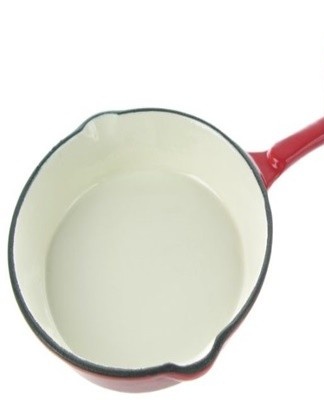
Without cover
The main advantage of a cast iron frying pan is the layer of oil formed on the surface, which prevents food from burning. At the exit, the main task is to preserve this impregnation.Therefore, it is necessary to handle cast iron cookware as follows:
- remove food from the pan immediately after cooking;
- do not loosen food debris with a knife, abrasives, wire mesh;
- do not use strong fatty solvents for dishes;
- do not soak pans in soapy water for a long time;
- do not boil water with soap.
Cast iron is a porous material. The more often you cook in the pan, the better, the walls become shiny. If the pan is used regularly, do not use harsh chemicals when washing, do not store it in a humid room, it is not necessary to grease it with oil after wiping it.
How to wash properly
After removing food debris, cool the pan. Do not pour hot cast iron with cold water. If there are any fried bits left on the walls, fill the container with warm water for 20-30 minutes, add a little mild soap, then wash. If there are no burn marks, wash immediately under warm running water, using soap if necessary. The pan does not squeak, like glass, washes, it always remains a little greasy. After washing, the dishes are dried with a towel and left to air completely.

Storage of cast iron cookware
Store cast iron pans in dry cabinets, away from sources of moisture and chemicals that can cause corrosion and unpleasant odors.
If you need to put other dishes on top, use cardboard or thin plastic spacers between utensils.
Preventative measures
The most common problems with cast iron cookware are carbon deposits and rust marks on the walls.Let's see how to maintain your frying pan to avoid these defects.
Rust
To prevent the appearance of rust, you must:
- remove dishes from the cast iron to keep them in an absolutely dry state;
- after washing, dry the pans with a cloth or paper towels, leaving no water drops until dry;
- renew the layer of oil when it becomes thinner - light the pan with oil every few months;
- empty cast iron pans immediately after cooking - do not store food.
If rust appears, you can remove it with a metal net or a vinegar solution, and re-soak the dishes with vegetable oil.
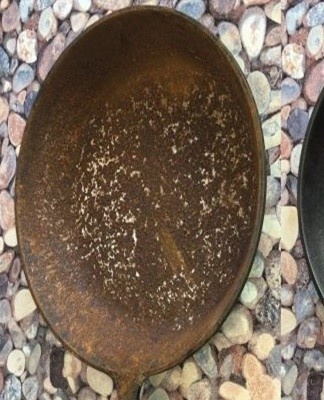
Nagara
The formation of carbon deposits is a natural process, grease splatters harden inside and outside walls. How to reduce the growth rate of soot:
- do not pour a lot of oil when cooking;
- do not keep the pan on the stove when they are not cooking in it, and splatters of fat fly off other dishes;
- maintain a non-stick coating at all times to prevent food from burning.
When washing, do not use harsh chemicals that will destroy the protective oil layer in the pan.
How to restore the non-stick properties of a material
Oil burn protection on cast iron is easy to destroy, but just as easy to restore. Therefore, frying pans are considered eternal. The same steps are required as for new cookware:
- light a frying pan with salt on a fire or in an oven;
- wash after cooling;
- pour oil and boil for a few minutes.
Then the pan is cooled, washed with warm water and dried.The dishes are ready for use again.
How to Care for Old Cast Iron Cookware
During operation, carbon deposits appear on the walls, the pan loses its dignified appearance, looks sloppy. Aggressive actions will be required that are not used with normal care. Let's see how to deal with stubborn old dirt.
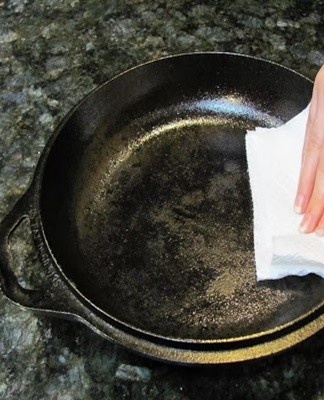
Inside
Internal carbon deposits can be dissolved in the following ways:
- Pour Coca-Cola or acetic acid solution into the pan for several hours. The liquid will dissolve the burnt layer on the sides and bottom.
- Use a wire brush to remove carbon deposits.
- Boil water in a pan with salt, vinegar and baking soda. The procedure is carried out until the liquid has evaporated.
Light dirt can be removed by moistening the walls with vinegar essence.
Out
The following methods are used to remove external carbon deposits:
- Burn a frying pan on an open fire - in the grill, on a fire.
- Roasting in the oven - temperature above 200°. The pan is placed upside down, kept for 2-3 hours.
- In a large container, a frying pan is boiled for 2-3 hours in the following composition - water, stationery glue, laundry soap, soda.
By applying physical force, you can peel off the external carbon deposits with an emery board, knife or special brush.
Common Mistakes
The most common cast iron cookware maintenance mistakes include:
- use when washing and soaking harsh chemicals;
- insufficient heating or overheating of the pan before laying the raw materials - you need to warm up for several minutes on low or medium heat;
- rubbing with oil after washing does not improve the non-stick properties of dishes (it should ignite), while the pan often acquires an unpleasant smell of rancid fat;
- a weak soap solution does not spoil the quality of the coating, it should be used when washing.
Inexperienced housewives often complain that they did not carry out the initial preparation of the casserole. There's nothing to worry about - it can be done anytime. Cast iron cookware forgives mistakes - you can always start fresh by updating an old pan.
Cast iron skillets remain popular with experienced chefs in upscale restaurants and ordinary housewives. The dishes just seem difficult to clean. In fact, it is easy to cook in it, convenient to wash. But the main thing is that the dishes cooked on cast iron delight with their taste and appetizing appearance.



